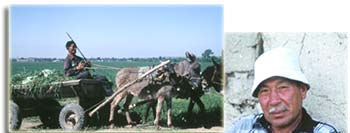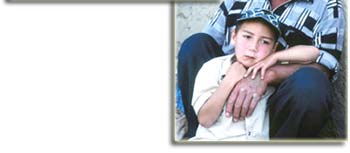September, 2004
  |
The introduction, testing, and promotion of bed planting technologies in Kazakhstan is one aspect of a project between CIMMYT and the German Agency for Technical Cooperation. Partners also aim to create a regional network in Central Asia and to identify, multiply, and promote high-yielding and disease-resistant wheat varieties that will increase productivity and profitability in farmers’ fields.
At first, some traditional farmers told farmer Alexander Merzlikin he was wasting his time experimenting with planting on raised soil beds. New technologies might seem risky to poor farmers who are afraid of losing yields. Merzlikin, who began farming in 1996 to feed his family, bites off the end of a green wheat stalk he is holding, chews it, and spits it out. These cautious farmers have short-term goals, he says, while he is looking to the future and to a sustainable harvest.
“They’re afraid to takes risks,” says Merzlikin, a former driver with light blue eyes, a sunburned face, and gray buzz-cut hair who lives near Almaty, Kazakhstan. He is wearing a yellow and red baseball cap and a blue striped polo shirt with sweatpants. “When land is the only source of income, you have to be sure.” He wants to show cautious farmers that planting with CIMMYT is fruitful, he says.
Merzlikin is excited about the results he has seen after growing wheat on permanent beds for three years. Making fewer passes with machinery in the field saves him almost 50% in fuel, he says. Also, his yields increased from about 2 tons per hectare to almost 4 tons per hectare in 2003. With bed planting, farmers might plant about half as many seeds as they would with conventional planting. In 2002, the project bought five bed planters from Turkey, and five more are being engineered and manufactured in Almaty. Merzlikin says the bed planting furrows allow for even water distribution, help prevent lodging, and make the usually difficult and labor-intensive process of water channeling unnecessary.
Increasing Productivity and Profitability
Merzlikin’s experience with beds is just one aspect of the project “Regional Network for Wheat Variety Promotion and Seed Production,” a collaboration between CIMMYT and the German Agency for Technical Cooperation (GTZ). Participants are aiming for a regional network in Central Asia to identify, multiply, and promote high-yielding and disease-resistant wheat varieties. As part of this, they have encouraged communication and collaboration in variety testing among breeders. At institutes in Central Asia, CIMMYT provided training for researchers and breeders, along with courses on agronomy and farm management. Farmers, agronomists, and administrators also attended field days where they learned about new varieties and soon-to-be available technologies. In 2003, 250 participants from 22 countries attended the first Central Asian Wheat Conference, which helped establish and strengthen links between scientists in the region and around the world. Also, the 40 scientists from Central Asia who have had training in wheat breeding and agronomy at CIMMYT’s headquarters in Mexico since 2000 currently contribute to the development and adoption of new varieties and technologies in their home countries.
Promoting Varieties and Seed
In collaboration with regional research institutions, project partners supported the testing of 5,750 experimental varieties between 2002 and 2003. Of those, they selected 790 that are tolerant to lodging and resistant to stem rust, which is the most common disease in the region. A small number of those varieties have already been released for farmer use.
One of the project’s objectives was to strengthen regional institutions that work on wheat breeding, research, and seed production. The partners helped establish private seed companies and supported the creation of a company that provides consulting services to farmers, sells seed, tests and promotes technologies, and submits varieties for official testing. Working with the project and bed planting technologies, this company supported five small-scale farmers in 2003 and 10 farmers in 2004, and it will support 15 farmers in 2005.
Driving a Road Far from Poverty
Economist Toni Rogger, who is funded by the German Development Agency and GTZ to work on the project’s poverty alleviation component, would like to get an overall picture about the constraints farmers in the region are facing and provide information to combat these problems. He also hopes that farmers see the benefits of new technologies and would like them to become more aware of all the components of farming, from A to Z, from soil to sales.
Merzlikin, who has an education in mechanics, epitomizes awareness. He found out that bed planting could be a cost-saving option while attending a CIMMYT-organized course that taught farmers how to calculate production costs. He and two partners combined each of their four hectares with land rented from other people to farm a total of 200 hectares. Even some cautious farmers have asked Merzlikin to help them introduce bed planting on their land, he says. For example, one poor farmer who needed a crop that would be easy to grow independently wanted to grow wheat instead of tobacco. Merzlikin helped him cultivate bed planting and says the resulting wheat looks good.
“To renovate a bicycle is an unnecessary job,” says the translator quizzically, uncertain if the expression the farmer used makes sense in English. Merzlikin thinks that because research and experiments have proven the success of certain farming methods, farmers do not need to reinvent the wheel to improve yields. He waves and chops his hands for emphasis as he talks. “I already knew when I was a driver that science was good and that scientists would help and give advice,” he says.